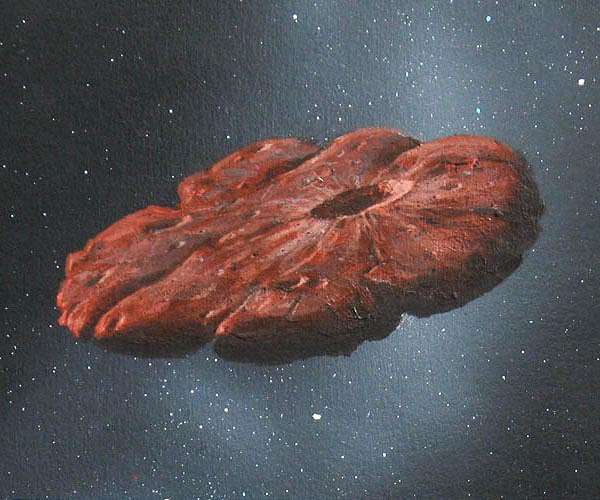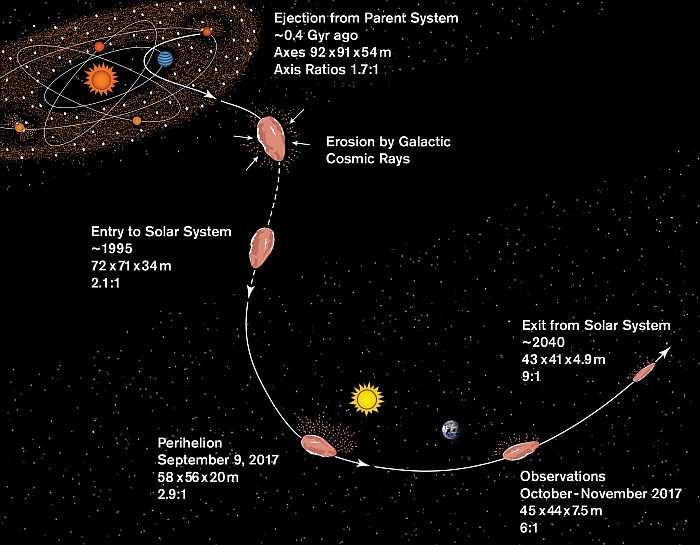
Oumuamua was name given to the mysterious interstellar object that passed through our solar system in 2017. What’s special about this object was, it happened to be the first that had come from ‘outside’ our solar system.
It was named Oumuamua meaning messenger from our distant past. It was first observed in October 2017 via the Pan-STARRS astronomical observatory in Hawaii. Since then, scientists have been analysing data from many observatories including NASA’s Hubble Telescope.
Oumuamua’s trajectory
The object is nearly half mile in length. And the trajectory of the cosmic visitor is recorded by Hubble.
Oumuamua displayed small continuous non gravitational movement.
Besides the gravity from sun, its trajectory was being influenced by something. Most probable conclusion could be jets of gas coming out from the object, quite similar to that of comets.
Oumuamua is not a comet
Ice in comets sublimates into gas and the subsequent streams (of gas) accelerates the object further in space. While doing so, the streams are observed in form of tail following the comet.
However, such dust tail is not observed in Oumuamua. This also makes it different from comet.
Initially, in this regard, it two speculations were made:
- maybe the object is without dust
- the dust is too sparse for us to observe
Cosmic visitor
Lately two Arizona State University astrophysicists, Steven Desch and Alan Jackson have claimed that the cosmic visitor is most likely a piece of a Pluto-like planet from another solar system. Also, Oumuamua’s several other characteristics makes it fall under different classification than a comet.
Velocity with which the object entered our solar system is less than what it was expected. Hence, astronomers believe that it had not been drifting in interstellar space for more than a billion years.
Lacks detectable escaping gas
Regarding the structure, the object is flat relative to other known solar system object. As mentioned above, it lacks detectable escaping gas.
As the object passed the sun’s orbit, researchers were able to calculate:
- rocket effect
- the object’s mass and shape and
- reflectivity of the ices
Solid nitrogen ice fragment of an exo‐pluto surface
Desch and Jackson then hypothesized that maybe the object is made up of different ices. Taking the research further, they discovered particularly solid nitrogen provides the exact match to Oumuamua features.
Interestingly, solid nitrogen ice is seen on the surface of Pluto and Triton, one of the largest of Neptune’s 13 moons. Therefore, the correlation between the object and the planet became obvious.
They then calculated the time span that’ll require solid nitrogen to scrape off from Pluto’s blanket and other stellar bodies in the history of solar system. And eventually, the probable time span of solid nitrogen ice chunks to reach and enter our solar system.

Sailing through half a billion years ago
Scientists claimed that huge impact might have resulted in knocking off solid nitrogen from the surface and out of its parent system. And the process of kicking off might have initiated about half a billion years ago.
Additionally, solid nitrogen is responsible for the rare shape of Oumuamua. No sooner with the evaporation of exterior layers of nitrogen ice, the object’s body have become gradually more flattened. Quite similar to a soap bar that turns flat as the usage progresses.
Alien technology or a fragment of Pluto
Abraham “Avi” Loeb an Israeli-American theoretical physicist in his recent book Extraterrestrial: The First Sign of Intelligent Life Beyond Earth speculates Oumuamua an extra-terrestrial artifact and a piece of alien technology. However, Desch asserted that it takes nearly two to three years to figure out a natural explanation.
Oumuamua, therefore is not an alien tech rather a fragment of a Pluto-like planet.
Takeaway
Objects like these help scientists to expand the base of their understanding of other planetary systems. At times, these external systems may look and behave like ours or either ways. There always has some or the other learning with each and every step till we reach at the final conclusion.
Researchers envision that with future telescopes, like Vera Rubin Observatory/Large Synoptic Survey Telescope in Chile, will surely assist in surfacing more interstellar objects. And scientists will be able to have more data in hand to understand and conclude in-depth analysis of collisional histories and solar system.



